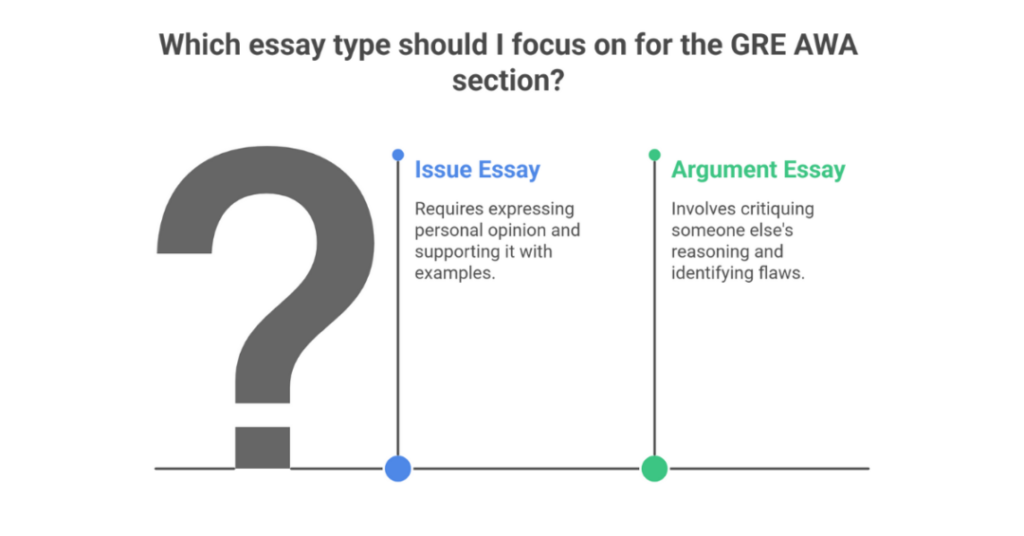3 September 2025
6 minutes read
GRE AWA Template: How To Write The Perfect AWA Essays?

Key Takeaways
- GRE AWA template: Use a clear structure, intro, body paragraphs with strong examples, and a conclusion, to organize your entire essay effectively.
- Focus on a strong thesis and logical flow, making sure each topic sentence and transition phrase guides the reader through the argument.
- Practice with GRE practice test prompts and review sample essays to refine your strategy and aim for a perfect 6 essay score.
Did you know? The GRE Analytical Writing Assessment (AWA) often leaves test-takers feeling overwhelmed, with only 30 minutes to craft a well-structured essay. It’s not just about writing; it’s about showcasing your critical thinking and persuasive abilities under time pressure. The real challenge is to address the specific instructions given in the essay prompts while maintaining a coherent essay structure that the grader can easily follow.
Many candidates struggle with structuring their essays effectively, often unsure how to start with GRE, what to include in each paragraph, and how to transition smoothly from one idea to the next. The pressure to produce a well-organized argument essay or issue essay prompt in such a short time can be daunting. But here’s the good news: using a solid GRE AWA template can help you streamline your thoughts, ensuring you write essays that are clear, concise, and compelling, ultimately boosting your GRE score. This blog will guide you through creating a foolproof AWA essay template that will make your analytical writing on test day feel like second nature.
GRE AWA Template: Issue & Argument Essays
The AWA section of the GRE consists of two essays:
- Analysis of an Issue (Issue Task) – also called the gre issue essay.
- Analysis of an Argument (Argument Task) – often referred to as the GRE argument essay.
ETS graders are evaluating the skill with which you organize, analyze, and present your ideas.

A well-structured essay could easily move you closer to a perfect GRE issue essay (6 essay) score.
GRE Issue Essay Template
Introduction Paragraph
- Begin with a clear statement of whether you agree or disagree with the prompt.
- Briefly highlight ways in which the statement might or might not hold true.
- End with a strong thesis sentence that guides the reader through the argument.
Sample GRE issue essay opening line:
“The statement might appear convincing at first glance, but closer analysis reveals reasons why it may not be universally valid.”
First Body Paragraph
- Start with a topic sentence introducing your strongest reason.
- Use examples to support your claim, ideally from history, science, education, or current affairs.
- Show how these examples support your thesis.
- Make sure your reasons or examples are not incorrect—accuracy matters.
Second Body Paragraph
- Introduce another strong reason.
- Add examples to support it, showing real-world relevance.
- If possible, acknowledge a counterpoint and explain why the statement might or might not apply.
- Use a transition phrase like “Furthermore,” or “In addition,” to keep your entire essay smooth.
Final Body Paragraph
- Provide your last key reason.
- Tie this back to your thesis and to the rest of the test structure.
- Show the reader will have access to clear logic and strong examples until the end.
Conclusion Paragraph
- Restate your position in different words.
- Summarize main points without repeating them verbatim.
- Close by stressing why your stance best addresses the issue task.
GRE Argument Essay Template
For the issue and argument difference:
- The issue task asks for your opinion.
- The argument task asks you to critique someone else’s reasoning.
Introduction
- Rephrase the argument.
- State that the conclusion is flawed due to questionable assumptions.
Body Paragraphs (2–3)
- Each body paragraph should highlight one flaw.
- Use phrases like “The argument fails to consider…” or “The reasoning is weakened because…”.
- Show ways in which the statement might not hold water.
Conclusion
- Restate why the argument is weak.
- Suggest what evidence would strengthen it.
Additional AWA Tips
- How long should GRE essays be? Around 500–600 words, though quality matters more than length.
- Always include a clear topic sentence in each body paragraph.
- Use gre words (sophisticated but natural vocabulary) to boost impression.
- Review a sample essay, GRE issue essay sample, or sample GRE issue essay from ETS. This helps you grade your essay against official standards.
- Use GRE practice test prompts to time yourself and practice writing the entire essay under test conditions.
- Remember: the reader will have access to the prompt while grading, so align tightly with the instructions.
This structure GRE template ensures you can handle any essay topics in the AWA section. With practice, GRE students can craft responses that show depth, organization, and clarity, hallmarks of a good GRE essay.
How To Write The Perfect GRE Analytical Writing Essay?
Crafting the perfect GRE AWA essay requires a strategic approach that ensures you articulate and develop an argument effectively while adhering to the specific instructions provided.

Whether you’re dealing with an issue you were assigned or tackling the argument task, your goal is to create a good essay that impresses the readers of the issue essay. Here’s a step-by-step guide to help you write an example that stands out on the GRE Analytical Writing Assessment.
1. Understanding the Prompt
Before you start writing, carefully read the essay prompts from the ETS. The prompt will either ask you to analyze an issue or evaluate an argument. Your essay should stand as a well-rounded response that directly addresses the specific instructions and articulate your position clearly. Remember, an issue essay that lacks a strong thesis or an argument essay that lacks a conclusion can significantly lower your score.
2. Structuring Your Essay
A typical GRE AWA essay follows a 5-paragraph short essay format. Start by structuring your first paragraph with a sentence stating your position on the issue or argument. The body of the essay should contain two to three paragraphs where you develop your argument using specific reasons or examples. Make sure to pepper your essay with relevant examples that could be used to support your thesis.
3. Developing Your Argument
In the body of your essay, you should articulate and develop an argument to support your evaluation of the issue. Use two strong reasons or examples that are relevant to the real world and show clear critical thinking. Be cautious: reasons or examples that are incorrect or irrelevant will weaken your argument. It’s also important to consider any opposing viewpoints and address them effectively to strengthen your essay.
4. Conclusion
Your essay should conclude by summarizing your main points and restating the issue or argument in a new light. A well-rounded essay that lacks a conclusion might leave the reader dissatisfied, which could impact your score. Make sure your essay stands out by tying all your arguments together in a compelling way.
5. Practice and Refinement
Finally, practice tests are essential for honing your skills. As you practice, focus on coming up with examples that are relevant and strong. Review essay examples on the official GRE website to see how high-scoring essays are structured. Many essays follow the same principles, but the key is to develop your argument in a way that is unique and convincing.
Conclusion
Writing the perfect GRE AWA essay isn’t about mastering complex writing techniques; it’s about clear thinking and effective communication. By following a structured approach, you can confidently address any prompt, whether it’s an issue or an argument. Remember, the key is to stay focused on your thesis, use relevant examples, and maintain a logical flow throughout your essay.
Practice is essential, but so is keeping your strategy simple and your mind sharp on test day. With the right preparation, you’ll be able to craft essays that not only meet the ETS criteria but also reflect your unique perspective. The GRE AWA is your opportunity to showcase your analytical abilities—make sure you make the most of it.
Transform Your GRE Results: Ambitio’s GRE Bootcamp Makes Excellence Achievable! Shift your GRE outcomes from good to great with our targeted approach, focusing on areas that yield the most significant score improvements.
FAQs
What is the purpose of the GRE AWA?
What are the two tasks in the GRE AWA?
The GRE AWA consists of two separately timed tasks:
Analyze an Issue task (30 minutes): You evaluate an issue, consider its complexities, and develop an argument with reasons and examples to support your views.
Analyze an Argument task (30 minutes): You critically examine a given argument, identify and analyze the line of reasoning, and present logical and convincing evidence
What are the 7 categories of GRE AWA topics?
The 7 categories of GRE AWA topics are:
Education
Technology and Society
Cities
Arts
Government and Power
Intellectual Endeavors
Philosophical
How is the GRE AWA scored?
The GRE AWA is scored on a scale of 0 to 6, in half-point increments. Two trained raters independently score each essay and the scores are averaged. If the two scores differ by more than one point, a third rater is used
How can I prepare for the GRE AWA?
To prepare for the GRE AWA:
1. Review the strategies, sample topics, sample essay responses with rater commentary, and scoring guide.
2. Practice writing at least three essays to get comfortable with the format and time constraints.
3. Familiarize yourself with the 7 categories of GRE AWA topics and practice analyzing issues and arguments
Can I retake the GRE AWA?

You can study at top universities worldwide!
Get expert tips and tricks to get into top universities with a free expert session.
Book Your Free 30-Minute Session Now! Book a call now




























